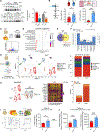Lipid-associated macrophages reshape BAT cell identity in obesity
- PMID: 38963761
- PMCID: PMC11693933
- DOI: 10.1016/j.celrep.2024.114447
Lipid-associated macrophages reshape BAT cell identity in obesity
Abstract
Obesity and type 2 diabetes cause a loss in brown adipose tissue (BAT) activity, but the molecular mechanisms that drive BAT cell remodeling remain largely unexplored. Using a multilayered approach, we comprehensively mapped a reorganization in BAT cells. We uncovered a subset of macrophages as lipid-associated macrophages (LAMs), which were massively increased in genetic and dietary model of BAT expansion. LAMs participate in this scenario by capturing extracellular vesicles carrying damaged lipids and mitochondria released from metabolically stressed brown adipocytes. CD36 scavenger receptor drove LAM phenotype, and CD36-deficient LAMs were able to increase brown fat genes in adipocytes. LAMs released transforming growth factor β1 (TGF-β1), which promoted the loss of brown adipocyte identity through aldehyde dehydrogenase 1 family member A1 (Aldh1a1) induction. These findings unfold cell dynamic changes in BAT during obesity and identify LAMs as key responders to tissue metabolic stress and drivers of loss of brown adipocyte identity.
Keywords: CP: Metabolism; adipocytes; extracellular mitochondria; immunometabolism; metabolism; mitochondria; single-cell RNA sequencing; thermogenesis; type 2 diabetes.
Copyright © 2024 The Author(s). Published by Elsevier Inc. All rights reserved.
Conflict of interest statement
Declaration of interests J.R.B. is a member of the Scientific Advisory Board and receives research support from LUCA Sciences, Inc., has consulted for DeciBio within the past 12 months, receives royalties from Springer Nature Group, and is an inventor on pending patent applications related to the treatment of metabolic diseases and immunoassay diagnostics.
Figures







References
Publication types
MeSH terms
Substances
Grants and funding
LinkOut - more resources
Full Text Sources
Medical
Molecular Biology Databases
Miscellaneous

